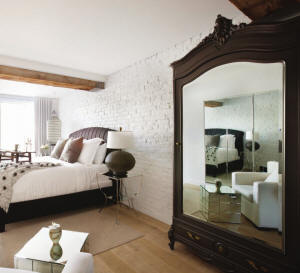|
 In other words, rooms often have themes; patterns in the ways
they are decorated or organized. With a bit of searching around, we
can found some of the common contemporary themes for home
decoration. In other words, rooms often have themes; patterns in the ways
they are decorated or organized. With a bit of searching around, we
can found some of the common contemporary themes for home
decoration.
A higher cost element of decorating serving big impact is furniture.
Larger furnishings may help personalities shine through, but more
importantly provide function to a home.
Living room furnishings
In recent years, television has brought forward a number of shows
such as ‘Mad Men’ or 'How I met your mother' that are period
related. These shows take place in past decades from the twentieth
century, and they try to create accurate representations of homes
and the way they looked. Due to the popularity of these types of
programs, we are seeing a return to a simpler form of decoration
with the rise of “mid-century modern” furniture.

_small.jpg)
A lot of mid-century modern furniture will look familiar to those
who lived in past decades, as modern designers have attempted to
recreate the look of it. Tables and chairs for living rooms and
dining rooms have thinner legs and are much shorter. Living room
tables have returned to being not just a space to set a drink or a
magazine, but instead often have shelves, drawers, or small cabinets
in them. New couches and chairs are often one solid color, although
a pattern of stripes is also common.
With the popularity of mid-century modern furniture, designers have
begun selling complete furniture sets that match. These sets share a
common color scheme or at least a small number of colors, resulting
in a simpler look for the living room. This could be a popular décor
choice for the older homeowner that wants to recreate past homes and
are feeling nostalgic. Unfortunately, a lot of this new furniture
can be very expensive.

On the other hand, decorators do not have to break the bank to go
for a mid-century look in the living room. Coincidentally, a lot of
older furniture is turning up in thrift stores and at garage sales.
This presents quite an opportunity for the furniture shopper looking
for bargains. Additionally, it also provides an opportunity for
bragging rights, as one could buy authentic mid-century furniture
instead of settling for modern recreations.
It is also worth noting that, as with any other trend, furniture
seems to operate in cycles. The younger generations looking to move
into their first homes are being drawn to the mid-century look for
both cost effectiveness (especially if their furniture takes the
form of old hand-me-downs) and aesthetic appeal. The quickest way to
redecorate for the homeowner or renter is to ask family members if
they have any old furniture they can part with, or to check thrift
stores. With a return to a simpler method of decorating, it likely
will not take long to find the essentials for a living space.
Bedrooms
Trends in bedroom decoration have not necessarily followed the same
lines of thinking that trends in living room furniture have
followed. Whereas trends in living rooms and other similar spaces
have reverted to earlier decades, bedroom decoration has not changed
much from recent years. This is especially apparent with children’s’
bedroom furniture.
[to top of second column] |


Similar to the living room table that doubles as a cabinet,
children’s furniture often serves multiple purposes. It has become
common to see a children’s bed that resembles a bunk bed or a loft,
with the mattress laying on a support frame over a space. Within the
space is often a small desk or a set of dresser drawers, or possibly
a small couch. It is also common to see larger sets of drawers on
either side holding up the bed.
Compared to the living room pieces, children’s furniture may seem a
lot more complicated. The likely reason for this is simple; today’s
kids have a lot more stuff than they used to. As a result, they need
more storage, but they also need the same furnishings, like a bed or
a desk. Additionally, a lot of the furniture kits that are sold are
customizable in some way, so not every child has to have a bedroom
set that matches what is on the box.

The major components of a child’s bedroom continue to reflect less
on their personality and more on their interests. It’s easy to find
bedsheets, curtains, posters, or anything that would decorate a room
with some kind of cartoon or movie character on it. In this way,
children’s décor remains where it has been, embedded in popular
culture. This makes decorating easy; just be sure that necessary
pieces in a child’s room stem from the same franchise.
In contrast to both a child’s room and the living space, the
parental bedroom does not follow any particular trends. As is the
case with living room furniture, the increasing costs of new
furniture have made it difficult to purchase anything for newer
homeowners or renters.

Once again, turning to family members for help or searching local
thrift stores can result in a room that holds a lot of older
furniture. Interestingly, the older furniture may starkly contrast
with whatever is in the room, such as televisions and other modern
electronics. This is how the personality of the inhabitant can shine
through, as new homeowners or renters represent a mix of old and new
ideas.
[Derek Hurley]
|